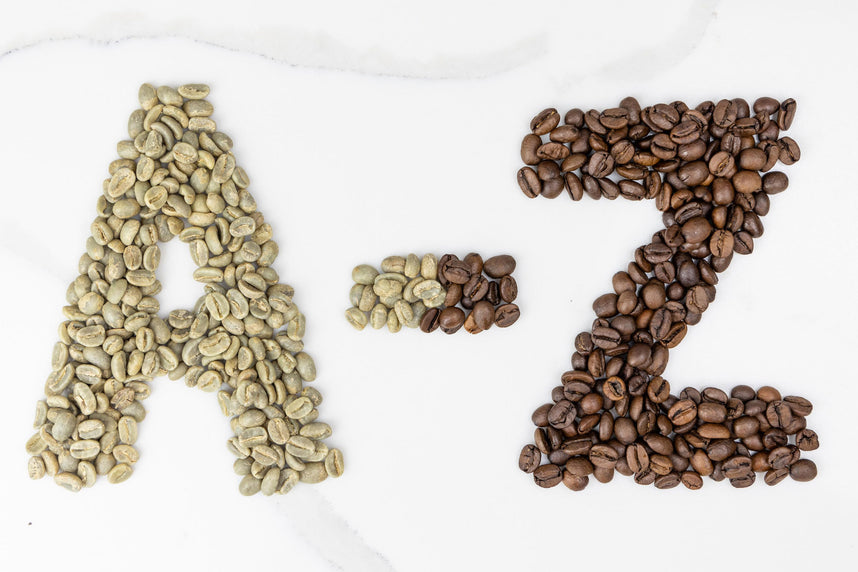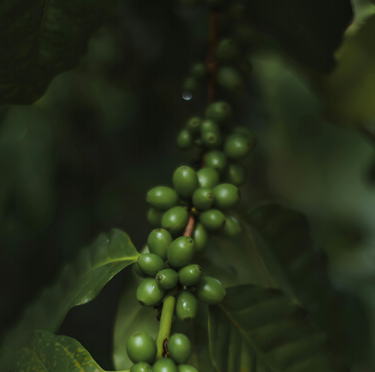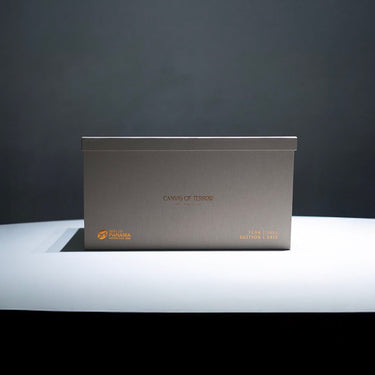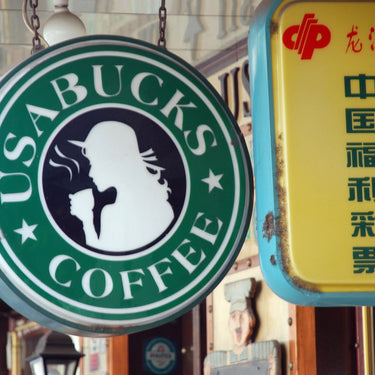So many buzz words in coffee and many names for the same things... we wanted to bust the jargon and bring you a no nonsense A-Z of Coffee!
A

Acidity: The tartness, brightness or liveliness perceived on the palate when drinking coffee. Along with body and aroma they make up the three essential components on which coffee is evaluated and categorised.
AeroPress: A piece of brew equipment for manually brewing coffee. Coffee is steeped in hot water before the plunger is pressed through a filtered tube.
Affogato: A popular coffee dessert – an espresso shot poured over a scoop of vanilla ice-cream.
Americano: A long black coffee where espresso is pulled on top of hot water to maintain the crema.
Anaerobic Fermentation: is the process of fermenting coffee in an oxygen free environment
Arabica: A species of coffee tree that accounts for 70% of the world’s coffee.
Aroma: The fragrance produced by freshly roasted & brewed coffee beans.
B

Barista: Italian term for a skilled coffee making professional.
Batch Brew: is pour over (filter) coffee whereby a machine dispenses water over the coffee - rather than manually pouring the water onto the coffee. It will drip water in stages rather than dispensing in one go.
Blade grinder: Machine that uses propeller-like blades to grind coffee. Considered inferior to a Burr Grinder due to inconsistent grind size.
Blend: A mix of two or more single-origin coffee beans.
Bloom: The rapid release of C02 gas when hot water comes into contact with ground coffee beans. Coffee blooming refers to the process of dampening the coffee grounds prior to brewing to maximise the release of C02 gas and flavour.
Body: The impression of the weight of the coffee in your mouth. Ranges from thin to medium to full.
Brew method: General term used to describe all the different ways to make coffee. Popular brew methods include drip, cold brew, French press, espresso and pour-over.
Bulletproof coffee: A high-calorie coffee drink blended with butter and MCT oil.
Burr Grinder: A set of grinders that uses two adjustable revolving surfaces (burrs) in between which coffee beans are ground - results in an even and consistent grind. Considered far superior to a blade grinder.
C

Caffeine: Natural compound found in coffee that is a stimulant to your nervous system.
Cafetière: Also known as a French Press - it is an immersion-style of brewing, which means the coffee sits with the water to extract before being strained or filtered through mesh.
Cappuccino: Style of coffee made up of espresso, 1/3 steamed milk & 1/3 microfoam. Often topped with chocolate powder. A stronger taste than a latte.
Chemex: A glass coffee brewer used to brew manual pour-over coffee. Uses paper filters and is considered to produce the cleanest taste of all manual pour-over methods.
Clever Dripper: is a mix between a French Press and a Pour-over coffee maker, bringing the best out of the two extraction methods; immersion and filter. The water sits with the coffee until you choose to sit it on your cup or vessel which releases the valve
Coffee pod: term for individual serves of coffee pre-prepared in small capsules for use in single-serve coffee machines.
Coffee to water ratio: Refers to the ratio of ground coffee beans to water volume. It varies depending on the coffee brewing method and is one of the secrets to brewing consistently great coffee.
Cold Brew: Very Coarse ground coffee beans steeped in chilled or room temperature water for 12 hours or more. A smooth coffee style popular in Summer served over ice or can be used as a base for other drinks such as espresso martinis.
Cortado: Style of coffee made with a single shot of espresso and a small amount of steamed milk.
Crema: The thick, caramel coloured foam that sits on top of a shot of espresso. Crema is formed when the water and coffee bean oils emulsify during the extraction process.
Cupping: The standard technique used by coffee professionals to taste and measure the quality of coffee.
C02 Decaf - This decaffeination process uses steam to open the pores of the green coffee, making it even more soluble. Then pressurised liquid CO2, a naturally occurring compound, is combined with the steamed green beans and the caffeine bonds with the CO2. As the solution is depressurised, and the CO2 evaporates, the pure caffeine is captured and removed.
Coffee Cherries - The fruit picked from coffee plants is known as the coffee cherry - within are usually two coffee seeds (also known as beans)

D
Dark Roast: Almost black beans with high levels of oil on the surface. Dark roast beans tend to have a thinner flavour, higher bitterness and lower acidity.
Decaffeinated coffee: Coffee with at least 97% of the caffeine removed (See also C02 decaf, Sugarcane Decaf & Swiss Water Decaf)
Degassing: The process of coffee beans releasing gases (mostly carbon dioxide) after roasting.
Demitasse: French word meaning a small coffee cup. Commonly used to serve espresso or macchiato.
De-stoner: A machine we run the beans through after roasting to find any potential foreign matter that may have shipped to us with the green coffee. This could be small stones, chips of concrete, small pieces of the coffee plant or twigs.
Doppio: Double shot of espresso with a small dash of hot water.
Drip Coffee: A style of coffee where the flavour comes from the beans coming in contact with water not under pressure. Percolators, countertop coffee makers and filters fit in this category.
Dry Cappuccino: A cappuccino that has less steamed milk and more foam.
DOF - Raves Head of Marketings and Brand abbreviation for his favourite drink > Decaf, Oat, Flat-white
E

Espresso: Coffee brewing method whereby hot water is forced at pressure through fine ground beans. Invented early in the 20th century in Italy.
Extraction: The brewing process whereby flavour is drawn from the coffee grounds.
F

Fairtrade coffee: Refers to coffee beans that have been produced to fair trade standards and ensures the coffee farmer is fairly compensated for their produce.
Filter basket: A metal round container with a perforated floor in which ground coffee is placed and tamped for preparing espresso. Can be dual walled (pressurised) or single-walled (non-pressurised).
Filter Coffee: Any style of coffee where water filters through ground coffee. Drip coffee made with a cone lined with paper is a commonly known type of filter coffee.
First Crack: This is a stage in the roasting process where the pressure within the bean reaches it peak and cracks the bean (it sounds a lot like popcorn popping!)
Flat white: A style of coffee made with espresso and topped with flat steamed milk to a total size of 6oz. Less milk than a latte. Less foam than a cappuccino.
Flavour: The flavour of coffee is the combination of aroma, acidity and body.
Frappe: A simple shaken or blended coffee drink made with lots of ice. Usually has syrups and whipped cream added.
French Press: (Also known as a Cafetière) Coffee made by steeping ground coffee in hot water in a (usually) glass cylinder. A strainer plate is pushed down once extracted to separate the grounds from the coffee. Also known as a press pot or plunger pot.
Frothing milk: Term used to describe how milk is warmed with a steam wand. With the addition of steam and air, milk becomes velvety and thick.
G
Gooseneck Kettle: Hot water kettle with a long narrow curved spout used to brew pour-over coffee. Gives you far more control over your pour than conventional kettles.
Green beans: Un-roasted coffee beans.
Grind: The size of the ground coffee beans. The ideal grind will vary depending on the brewing method used.
Group Head: The section of an espresso machine that holds the portafilter in place when brewing.
Giling Basah: translates as wet-hulled a coffee processing method.
H
Hopper: The container on top of a grinder where beans are stored before they are ground.
Honey Process: is a method in which coffee cherries are picked and sorted, have their skins and pulps removed like other types of coffee - but are then dried without washing off the sticky-sweet outer layer of the fruit.
I

Immersion Coffee Brewing: This refers to ground coffee being immersed in water to brew and extract flavour. See Cafetière/French Press/Clever Dripper
Instant Coffee: A type of soluble coffee made from freshly ground coffee that has been brewed and then dehydrated to form dried coffee granules.
Irish Coffee: Coffee with a dash of whiskey added and topped with cream.
J
Java - Although Java is another term used to refer to a cup of coffee, it is also a specific type of arabica coffee bean. As you might have guessed, Java Arabica coffee is grown on the island of Java
K
Kopi Luwak - famed for being the most expensive type of coffee in the world. Produced from Civet cats eating coffee cherries and the coffee beans are collected from their faeces. Although the production of this coffee raises many ethical questions and actually can be seen as more of a gimmick.
L
Latte: Style of coffee made with espresso and topped with steamed milk and a thin layer of foam. Standard size 8oz (single shot) or 12oz (double shot)
Latte Art: The pattern formed when steamed milk is poured into a cup of espresso.
Light Roast: Coffee beans are roasted for a short amount of time. Lighter body, no oil, often cinnamon in colour. More flavour of origin comes through than other roast styles.
Loring: Is the brand of our Roaster we use to roast our green coffee beans. It is one of the most efficient machines on the market.
Lungo - A longer espresso
M

Macchiato: Style of coffee made with espresso and a small dash of foam or steamed milk. Literally means “to mark” or “to stain” in Italian. Typically 2-3oz in total.
Maillard Reaction - Chemical reaction during roasting where the amino acids and sugars start to change the colour of the beans to brown.
Medium Roast: Coffee beans are roasted for more time than a light roast and less time than a dark roast! Milk chocolate in colour with little oil on the surface. More depth of flavour with less acidity and a touch more sweetness as at this stage the beans will begin to caramelise.
Microfoam: Term used to describe milk heated to perfection with a steam wand to become velvety smooth and thick. Essential for great latte art.
Microlot: are small lots of coffee, selected for their high quality and unique flavour profiles. Grown in limited quantities and picked and processed entirely separately to the rest of the farm's lots.
Mocha: Style of coffee made with espresso, steamed milk and chocolate syrup or powder. Sometimes topped with cream.
Moka Pot - (Also known as StoveTop) The Moka Pot is a stove-top or electric coffee maker that brews coffee by passing boiling water pressurised by steam through ground coffee. It was invented by Italian engineer Alfonso Bialetti in 1933 and quickly became one of the staples of Italian culture. Famed for producing syrupy strong coffee - probably the closest brew method to Espresso.
N
Nitro coffee: Cold brew coffee injected with nitrogen from capsules to produce a velvety, smooth brew similar in texture to a stout beer.
Non-Pressurised (single-walled) Filter Basket: Original style filter basket. Coffee is extracted directly into the cup. Quality of the grind and tamp are more important factors to produce a consistent, high quality espresso.
Natural Processed Coffee: This is the process of drying coffee beans with the cherry left intact. This can take between two and six weeks, depending on the region and climate.
O
Organic Coffee: Coffee certified to have been grown and processed according to strict supply chain management processes set by the Soil Association (UK).
P

Piccolo: A small latte - a single shot of espresso topped with steamed milk usually around 6oz, less strong tasting than a flat white.
Percolator: A coffee percolator is a type of pot used for the brewing of coffee by continually cycling the boiling or nearly boiling brew through the grounds using gravity until the required strength is reached - often leads to over extraction and had fallen out of favour over the years.
Pods: (see coffee pod)
Portafilter: Device used on espresso machines, typically metal with a plastic handle, that holds the coffee filter basket and attaches to the group head.
Pour Over: A brewing method where hot water is poured over ground coffee beans held in a filter that is resting over a coffee cup or vessel.
Pressurised (Dual Wall) Filter Basket: Filter basket with a double base. Extracted coffee is forced through the filter basket into a second chamber with one small hole through which the espresso is extracted. The second chamber creates a greater level of pressure. Commonly found on entry-level espresso machines to help improve the consistency of espresso as the quality of the grind and tamp is less important.
Puck: The spent coffee from a portafilter after brewing espresso.
Pull: A traditional term from when espresso machines had levers. Espresso shots are ‘pulled’.
Pulped Natural: is a coffee processing method where the skin is removed from the coffee cherry. This leaves the fruity mucilage still intact during the drying process. Mucilage is the thick, gelatinous substance produced by all plants. So basically the coffee is dried with this sticky fruit pulp still attached.
Q
Q Grader: The Q grader programme was established in 2004 as a way to objectively examine coffees and score them based on their many attributes and therefore overall quality – it is in fact the only certification in the industry that is based on quality
Quakers: are unripened beans that are hard to identify in green un roasted coffee beans. Often, but not always, caused by poor soil conditions which limit sugar and starch development. Technically this isn’t a roast defect, but often you’ll only discover it after roasting. Quakers will appear lighter in colour than the rest of the batch. If they’re not removed, the taste in the cup will be dry, with papery and cereal notes.
Quality: Coffee quality is very important - speciality coffee is recognised by scoring 80+ points (out of 100) The quality of coffee deteriorates over time, in green bean form as well as roasted coffee.. Our roasting team test samples of coffee throughout the whole purchasing process before we receive a delivery to determine the quality.
R
Ratio: Are commonly used in brew methods for coffee - In espresso brewing we recommend a 1:2 ratio so for 18g of coffee you would expect 36g of espresso out. For pour-over and immersion methods, we recommend a 1:16 ratio as a starting point.
Ristretto: A style of coffee where the espresso is pulled short with less water to produce a stronger more concentrated coffee.
Roast: The process whereby green coffee beans are heated to roast the beans and create the flavours that are extracted during brewing.
Robusta: A species of coffee tree that produces coffee considered of inferior quality. Most commonly used in instant coffee and pre-ground coffee. Has a higher caffeine content than Arabica
S
 SCA: Stands for the Specialty Coffee Association, a membership organisation for everyone from farmers to baristas involved in the coffee trade.
SCA: Stands for the Specialty Coffee Association, a membership organisation for everyone from farmers to baristas involved in the coffee trade.
Scales: A coffee scale is a device used to weigh coffee beans and grounds, espresso extraction as well as time manual pour-over brewing methods.
Shot: A single serve of espresso.
Single cup: Coffee machines that brew a single cup of coffee at a time. Examples include Nespresso® and Keurig machines.
Single Origin: Unblended coffee from a single country, place and/or farm.
Siphon Coffee: A manual coffee brewer that uses a heating element and vacuum pressure to extract coffee. Also known as a vacuum coffee pot.
Steam wand: The arm on an espresso machine used to heat and froth milk. Pressurised steam is released through the nozzle into the milk. Air is incorporated into the milk to produce textured microfoam.
Stove Top - Also known as Moka Pot
Sugarcane Decaf - A relatively new decaffeination process - Sugarcane is fermented which creates a naturally produced chemical Ethyl Acetate (EA). Green beans are steamed to open the pores and then introduced to a water solution with the EA. This process is repeated until 95% off the caffeine is removed. The beans are then gently steamed to remove any trace of EA, they are then dried and packaged for export.
Swiss Water Decaf - The only method to boast a zero chemical approach to decaffeinating coffee. The Swiss water company uses a clever combination of water and a caffeine deprived coffee extract (GCE) together with temperature and osmosis to draw out the caffeine from the green coffee beans.
Skinny (Latte/Cappuccino) - A drink made with skimmed milk.
T
Tamper: Small cylindrical device used to distribute and compress ground coffee into the filter basket for espresso brewing.
Turkish Coffee: Style of unfiltered coffee made with extra fine ground coffee beans brought to the boil often with sugar added. The coffee is served unfiltered – allowing time for the grounds to sink to the bottom of the cup before drinking.
U
Urn: An extra-large coffee maker, used to make coffee for large groups. Coffee Urns use the percolating brewing method.
V

v60 - A filter brew method with a v shaped cone where the sides are 60°
Varietal: There are many varieties of coffee plants, many have been cross bred over the years to create higher yields or to increase resilience to pests. Much like wine where you have many varietals of grapes, the same applies to coffee
W
Wet Milling - is the process of washing the coffee fruit and seed, to prepare it for drying.
Washed Process - Probably the most common coffee processing method. This is the process where the coffee bean has had various fruit layers removed before the drying process begins
Wet Processed - See washed process
Wet hulled - Also known as Giling Basah, a coffee processing method common in Indonesia.
White Coffee - A coffee with milk added






